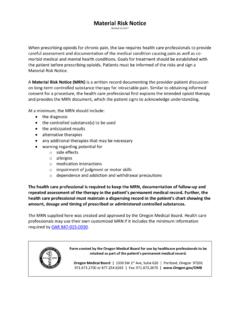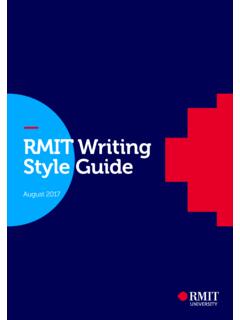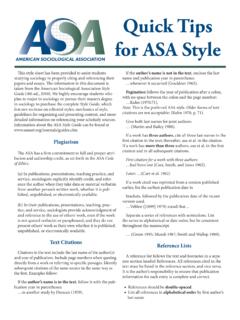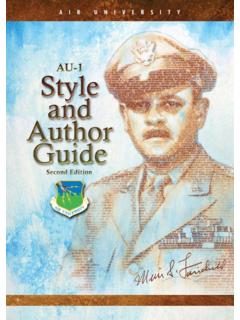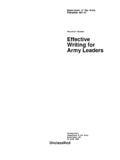Transcription of Web Writing Style Guide - oregon.gov
1 oregon DEPT OF TRANSPORTATION 10/2/2016 Web Writing Style Guide Helpful guidance for Writing useful and usable content for our audiences. 1 Table of Contents Introduction .. 3 Vision .. 3 Goal .. 3 Core Strategies .. 3 How to Use This Guide .. 3 Important Notes .. 3 Tips .. 3 Writing for the web is Different .. 3 Select the Right Content for the Right Audience .. 4 Voice and Tone .. 4 Keep it Simple .. 4 Write Visually .. 5 Links are your Friends.
2 5 Create useful links .. 5 Don t recreate the wheel .. 6 Find a buddy .. 6 Avoid common pitfalls .. 6 PDF vs. web page .. 7 Editorial Style Guidelines .. 7 Jargon & Acronyms .. 7 General Style .. 8 Addresses .. 8 8 Commas .. 9 Contractions .. 9 Dashes .. 9 2 Data Entry Forms .. 10 Dates .. 10 Dimensions .. 10 Directions and Regions .. 11 Expressing Urgency .. 12 Hyphens .. 12 Meeting Notices .. 12 Money .. 12 Notations/Notes .. 13 Numerals .. 13 Parentheses .. 14 Prepositions .. 14 Quotation Marks.
3 14 Ranges .. 14 Semicolons .. 15 State Names .. 15 Telephone Numbers .. 15 Temperatures .. 15 Time .. 15 Title Case and Capitalization .. 16 Vertical Lists (Numbered & Bulleted Lists) .. 17 Weights .. 17 Terms, Acronyms and Commonly Misused Words .. 18 Frequently Asked 22 Driving Directions (DMV only) .. 23 Appendix A Style & Standards Guide Sources .. 24 1. Web Governance and Plain Language .. 24 2. Accessibility & Usability Guidelines .. 24 3. Writing for the web .. 25 3 Introduction Oregonians prefer the web as the primary means to contact or get information from state agencies.
4 As such, it is vital the oregon Department of Transportation s website be as clear and easy to use as possible. The purpose of this Web Writing Style Guide is to help us write useful and usable content for our audiences. Our Governance Plan and Content Strategy serves as an overarching Guide for our website. Vision Our vision is to have a mobile-first, useful and usable website that improves the agency s ability to communicate with our audiences (customers and stakeholders), helps people find needed information and complete tasks, reduces risk and improves transparency.
5 Our site conveys and amplifies the agency s mission, goals and work. Goal Aligning with ODOT s mission, ensure our internet website provides current, efficient, effective, accurate, consistent and quality information, resources and services for customers, stakeholders and employees. Core Strategies Audience first: The key to creating good web content is to understand our intended audiences and to design information based on their specific wants and needs. Task oriented: People come to our website for content that they think (or hope) is there.
6 They want information that answers a question or helps them complete a task. Quality vs. quantity: To provide useful and usable information for our audiences we must carefully select and edit the information that we choose to post. Consistent brand: Our internet website maintains a consistent experience across pages. ODOT s web pages conform to agency standards for communication and branding, while still allowing for division brand identity. How to Use This Guide Important Notes Important notes provide information that must be considered when creating content.
7 Tips Tips provide information to make creating content easier. Writing for the web is Different Most web users are very busy people who want to read only as much as they need to satisfy the goal that brought them to the web. 4 Tip: Your reader says Tell me what I need to know. Write to me, not to a group. Anticipate my questions. Don t confuse me. Important: DAS Web Guidelines recommend Writing at no higher than eighth-grade level. Web users skim and scan. Only 16 percent of your audience is going to read your web content word for word.
8 Think of your web content as part of a conversation. We are required to follow the ODOT plain language standard; for more examples, see the DAS Editorial Style Guide . Select the Right Content for the Right Audience Think about your audience before Writing or posting one word. Before you write: Know your audience and your purpose. Write for your specific audience, not for everyone. Use the ODOT personas list to help your write for your audience. Personas are brief character sketches representing specific audiences.
9 People come to our site to complete a task. They need information. They need to complete a transaction. They need to comply with a rule or law. There is something that they need or want to accomplish. We call these top tasks. Use the ODOT top task list to ensure your content meets specific audience needs. Voice and Tone The site s tone is conversational and customer-friendly, using language commonly understood by our audiences. We are positive and professional. We write clearly and concisely. We respect our audiences time.
10 Keep it Simple Our website should make sense to our audience and to us. We follow Plain Language Guidelines. Plain language is communication your audience can understand the first time they read it or hear it. We are required by state and federal law to use plain language in all of our external communications aimed at the public. ODOT s Plain Language Guidelines and Plain Language Training are essential resources for web editors and content writers. In addition to using plain language: Present the main or essential message first.









